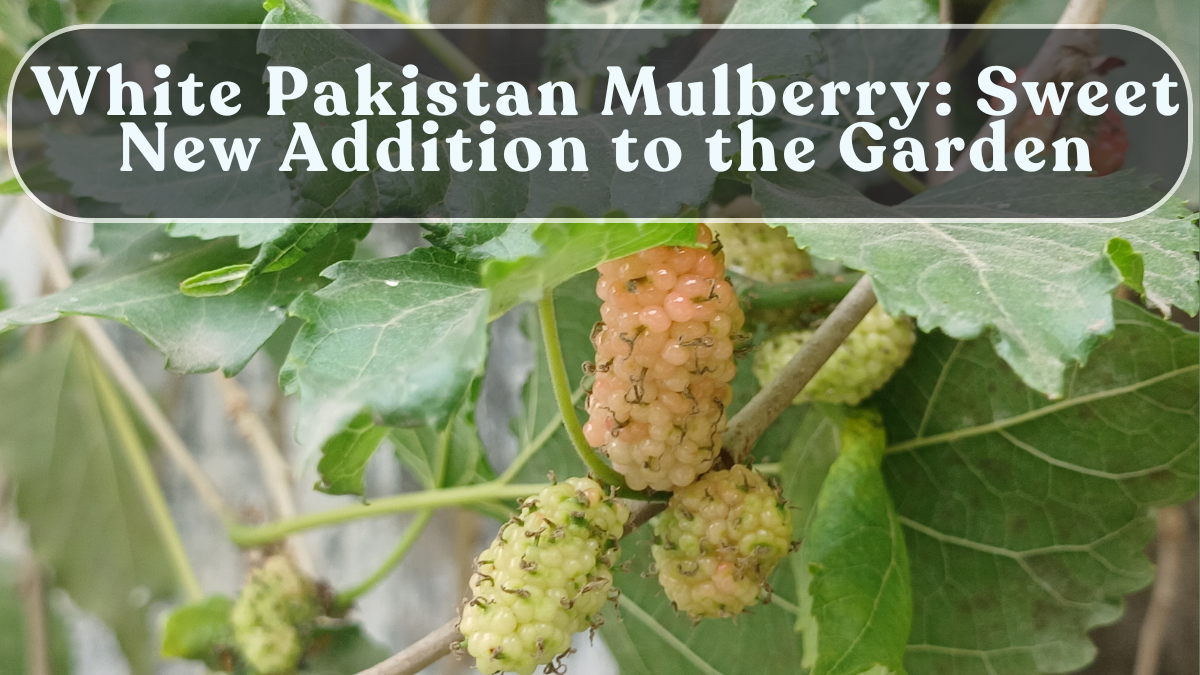The White Pakistan Mulberry is one of the most delicious and unique fruit trees you can grow in your home garden. Known for its long, white, honey-sweet berries and impressive yield, this mulberry variety is easy to grow and highly rewarding. Whether you have a backyard, small orchard, or large containers, this guide will show you how to plant, prune, and care for the White Pakistan Mulberry tree successfully.

About the White Pakistan Mulberry
Unlike the common red or black varieties, the White Pakistan Mulberry (Morus macroura) produces long, creamy-white fruits that can grow up to 3–4 inches in length. The berries are incredibly sweet, with a mild floral note that makes them perfect for fresh eating, jams, or desserts.
This tree grows quickly, producing fruit within 1–2 years of planting under the right conditions. It’s a hardy species, tolerant of warm climates, and ideal for tropical and subtropical regions.
Ideal Climate and Soil Conditions
White Pakistan Mulberries prefer warm, sunny locations and well-draining soil.
-
Temperature: 20°C–35°C is ideal.
-
Sunlight: At least 6–8 hours daily for maximum fruiting.
-
Soil type: Loamy or sandy soil enriched with organic compost.
-
pH level: Slightly acidic to neutral (6.0–7.5).
Avoid waterlogged areas, as excessive moisture can damage the roots and reduce fruit quality.
Planting Guide
-
Choosing the spot: Select a sunny, open area with space for the tree to spread (about 12–15 feet from other trees).
-
Soil preparation: Mix garden soil with well-rotted compost or cow dung manure before planting.
-
Planting depth: Dig a hole twice the size of the root ball. Place the sapling in the center and fill gently, pressing the soil around it.
-
Watering: Water thoroughly after planting and keep the soil moist for the first few weeks.
If you’re growing it in a large pot, ensure it’s at least 20–24 inches deep and has excellent drainage.
Watering and Fertilization
The tree needs moderate watering—once every 3–4 days in summer and once a week in winter. Avoid overwatering, as this can cause root rot.
Feed your mulberry tree twice a year:
-
Spring: Use organic compost or vermicompost for vegetative growth.
-
Mid-summer: Apply bone meal or potash to encourage fruiting.
A layer of mulch around the base helps retain moisture and regulate soil temperature.
Pruning and Maintenance
Pruning keeps your White Pakistan Mulberry healthy and productive.
-
When to prune: After the fruiting season or in late winter before new growth begins.
-
How to prune: Remove dead or crossing branches and shape the canopy for sunlight penetration.
-
Tip: Regular pruning promotes new shoots, leading to more fruit-bearing branches.
Keep the area around the tree weed-free and check for pests like aphids or mealybugs. Neem oil spray is an effective organic control.
Harvesting and Taste Notes
The berries ripen during spring and early summer, changing from pale green to creamy white when fully ripe. They are extremely juicy, soft, and sweet—often compared to honey with a mild vanilla-like aroma.
Harvest gently by hand or by shaking the branches over a clean sheet. The fruits are delicate, so handle them carefully to avoid bruising.
Uses and Benefits
White Pakistan Mulberries aren’t just tasty—they’re also packed with nutrients.
-
Rich in vitamin C, iron, and antioxidants.
-
Great for immune support and digestion.
-
Can be used in smoothies, jams, juices, and desserts.
The leaves are also beneficial for silkworm rearing and herbal teas.
Conclusion
The White Pakistan Mulberry is a must-have for any fruit lover’s garden. With its luscious, sweet berries, fast growth, and easy care routine, it brings both beauty and flavor to your backyard. Whether you’re planting it in the ground or in a pot, this unique variety will reward you with years of delicious harvests and a stunning ornamental presence.
FAQs
How long does it take for a White Pakistan Mulberry to fruit?
It can start fruiting within 1–2 years after planting under good care.
Can I grow it in a pot?
Yes, use a large 20–24 inch container with rich, well-draining soil and full sunlight.
How tall does the tree grow?
It can reach 25–30 feet but can be pruned to maintain a smaller size for home gardens.
Do I need more than one tree for pollination?
No, it’s self-pollinating, so one tree is enough for good fruit yield.
When is the best time to plant?
Plant during spring or early monsoon, when temperatures are mild and soil moisture is ideal.
